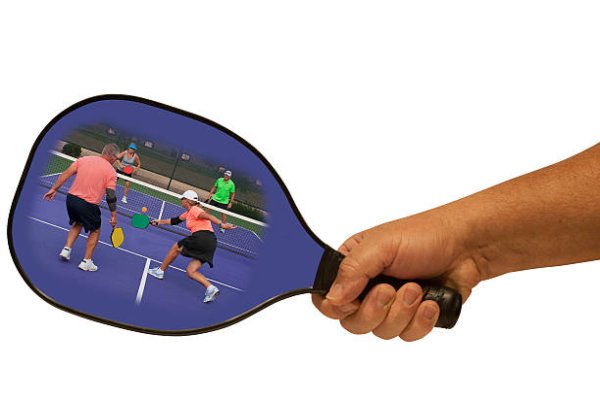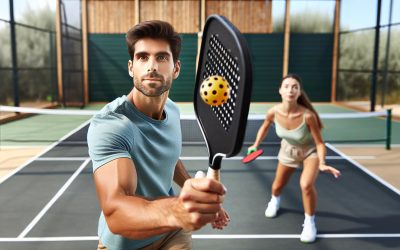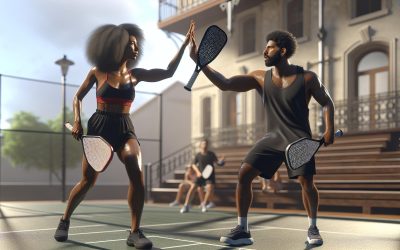Pickleball’s taken the sports world by storm, and I’m here to help you master it. It’s not just about quick reflexes or raw power – strategy is key. I’ll be sharing some top-notch pickleball strategies that could turn the tide in any match.
Whether you’re a seasoned pro or just starting out, these strategies can give you an edge. We’re talking about positioning, shot selection, and even psychological warfare. Stay tuned, because I’m about to spill the secrets that could take your pickleball game to the next level.
Remember, every point in pickleball counts. With the right strategies, you’ll not only outplay your opponents – you’ll outthink them. Let’s dive right into the world of pickleball strategies and discover how to play smarter, not harder.
Positioning and Court Coverage
No matter how talented you are with a pickleball paddle, without proper positioning and court coverage, your game will suffer. The importance of dominating the court and anticipating each move is a fact that’s often overlooked by novice players.
Your position on the court plays a crucial part in dictating the flow of the game. It’s about getting the utmost value from your shots while minimizing the risk of errors. Positioning is not about always sticking to the center of the court. It’s about adapting to the circumstances, tracking the movement of the ball and adjusting your position on the spot.
Effective court coverage, like positioning, requires a certain level of game understanding and anticipation. Being successful at pickleball involves honing your ability to predict where the ball might land and position yourself accordingly – not a small feat I assure you!
Let’s take it a bit deeper now. Consider a game situation where the opponents target one player more frequently than the other. The frequently targeted player should shift towards the center of the court, thus enabling better court coverage. Meanwhile, the other player must compensate by shifting towards the sideline and the baseline. These small shifts in positions increase court coverage and reduce the probability of hitting faulty returns.
Remember these tips about positioning and court coverage:
- Anticipate your opponent’s moves.
- Adjust your position according to the game’s circumstances.
- Cover the court effectively by tracking the ball and predicting its landing spot.
By mastering these elements, you’ll be able to move the ball, control the game, and, most importantly, outsmart your opponents.
Serve and Return Strategies
In pickleball, a player’s serve and return strategies are as critical as positioning and court coverage. They’re the foundation of any successful game. In this section, we’ll delve into some serve and return strategies that you can implement to step up your game.
When it comes to serving, consistency is key. You want to send the ball deep and low, aiming towards the baseline of the opponent’s court. This kind of serve can restrict your opponent’s spot selection for the third shot.
Contrary to the powerful serves in tennis or badminton, pickleball serves are less about power and more about placement. One popular strategy is the use of ‘drives’. With a low, hard drive serve, you aim to reduce the opponent’s time to react, forcing them on the defensive from your first strike.
Let’s shift gears to the return of serve. You’ll want to aim for a deep return that forces your opponent back towards their baseline. This maneuver gives you and your partner enough time to get to the kitchen line—prime position for controlling rallies.
An effective strategy here is the ‘third shot drop’. By making a slow, high arching shot over the net, the ball drops into the opponent’s kitchen, making it difficult for them to return an aggressive shot.
To up your pickleball game, focus on serve and return strategies that emphasize consistency, placement, and skillful prediction. Master these, and you’ll not only get better control over rallies, but also enhance your overall game.
Shot Selection and Placement
When we dive deeper into the dynamics of pickleball, it’s evident that shot selection and placement play a significant role in determining the match’s outcome. Being reactive isn’t enough, you’ve got to be proactive. You should attempt to dictate where your opponent can hit their next shot. If you guide their play, you’re in control of the game.
Your shot shows your intention. Are you trying to keep them deep in their court or drag them close to the net? Are you aiming to their backhand to exploit a weaker return, or testing their forehand? Every shot has a purpose, and it’s essential to make that purpose serve your larger game plan.
One useful strategy is to mix up your shots frequently. Unpredictability can work in your favor; if your opponent cannot anticipate your shots, they’re less likely to set up a strong return. Some shots you can use are deep baseline shots, dinks (a soft shot that drops over the net), and volleys (a shot taken out of the air before it bounces). You can also consider shots to their middle, down the line, or out wide to keep things varied.
Seizing the varying levels and angles can frustrate your opponents and open up chances for you. Displaying a variety of shot selection helps to keep your opponent guessing while providing you ample opportunities to capitalize on their errors. However, this can be a double-edged sword if you’re not careful. Attempting a variety of shots without practice may lead to unforced errors, so it’s important to practice all types of strokes and shots you plan on using in your games.
A good shot isn’t just about placement. It also requires the right pace, spin, and trajectory. Your shot’s speed can also dictate the pace of the game, a faster shot can speed up the game while a slower shot can help you regain control with a softer pace.
Remember, in pickleball, learning to consistently place your shots where you want them to go is a skill that players at all levels continually strive for. It’s a skill that can elevate your game to the next level. It’s not the flashiest part of the game, but it’s a fundamental aspect that can lead to more consistent wins.
Choose wisely, execute confidently, and watch your game evolve.
Mastering the Dink
In the fascinating game of pickleball, one of the most proficient techniques you can hone is the “dink.” Don’t let the goofy name fool you; it’s an imperative aspect to cabin your opponents’ aggressive play. Using a distinct dink strategy keeps the ball low, making it harder for opponents to respond with a fast or aggressive shot. It’s an exceptional way to make the game run on your terms.
Here’s a guide to mastering the dink, and remember, it’s all about finesse and control, not force and speed.
To execute the perfect dink, position yourself close to the net. The idea is to softly hit the ball just enough so that it directly drops into the non-volley zone of your opponent’s side of the court. The key is to ensure the ball sails over the net but still lands within the designated area.
Another vital component to mastering the dink is anticipation. Predicting your opponent’s movements and understanding their strategy will definitely give you the upper hand. Use the dink to challenge them by constantly keeping them moving and adapting to your shots. Trust me, it’s easier said than done, but practice makes perfect in prying open this skill set.
Know that each opponent is different and will react differently to your dinks. So, it’s of prime importance to be flexible and change your strategy as per their responses.
Wondering how to practice those perfect dinks? Let’s give you some quick drills to help you improve:
- Practice against a wall: Repeatedly dink the ball against a wall to get a feel for the shot.
- Partner up: Pair with a partner, stand close to the net, and try to maintain a continuous volley only using dink shots.
These drills are designed to help you understand the trajectory and force needed for a successful dink. Keep at it, adapt as necessary, and watch how your pickleball game transforms.
Psychological Warfare on the Court
Don’t overlook the power of mental tactics in pickleball. The ability to manipulate your opponent’s mind can be just as effective as delivering a powerful overhead slam. Let’s discuss a few key psychological strategies that can give you an edge in the game.
First, it’s all about strategy. When playing pickleball, I like to mix up my shots frequently, consistently throwing my opponent off guard. This not only keeps them guessing, but it also disrupts their rhythm, making it more challenging for them to anticipate my moves. It’s essential to keep altering the pattern of your gameplay to keep your opponent on their toes.
Building on the idea of strategy, deception is another key element of psychological warfare on the pickleball court. I find it particularly useful when facing opponents who tend to predict my shot direction. For example, if I frequently send the ball to their deep corner pocket, they’ll eventually anticipate this move. I can then use a feint, showing signs that I’ll play the ball to the corner again, but at the last moment, I’ll change direction and surprisingly send it down the middle. Deception, when used skillfully, can completely dismantle an opponent’s defense.
Additionally, maintaining a calm and composed demeanor, no matter the situation, can significantly impact your opponent’s mental state. A calm player seems more controlled, leading the opponent to question their abilities and strategies.
Practicing Psychological Strategies
These last few segments have been heavily theoretical. Let’s get practical now. Here are some recommended drills to practice:
- Mock Play – simulate a match scenario and implement different strategies to deceive your opponent. Focus on altering your shot selection and style.
- Shot Deception Exercise – practice faking your opponents out by feigning one direction and hitting in another.
- Stay Calm Drill – purposefully put yourself under pressure by playing against opponents stronger than you. The aim here is to focus on staying calm and making smart decisions.
But remember, mind over matter does not mean that you can neglect the physical aspects of pickleball. So, it’s crucial to balance mental warfare on the court with your regular pickleball drills and techniques practice. This cocktail of physical and mental skills can create a formidable player.
Conclusion
So, we’ve delved deep into the world of pickleball strategies, dissecting the importance of shot selection, mastering the dink, and honing psychological tactics. It’s clear that being proactive in dictating the course of play can significantly up your game. Variety in your shots keeps your opponent on their toes, and a well-practiced dink can be a formidable weapon. But remember, it’s not just about physical skills. The mental aspect of pickleball is equally crucial. Deception, calmness, and adaptability can give you that much-needed edge. And don’t forget, practice makes perfect. Whether it’s drills for shot precision, dink mastery, or psychological tactics, consistent practice is key to improvement. So, get out there, keep these strategies in mind, and watch your pickleball game soar to new heights.














0 Comments